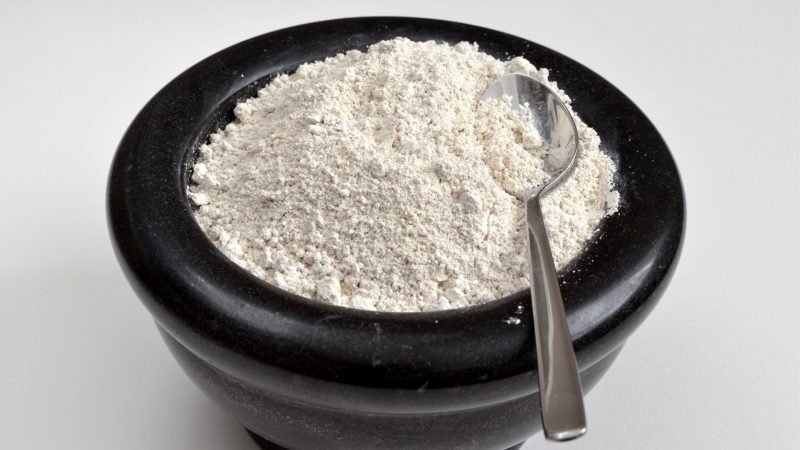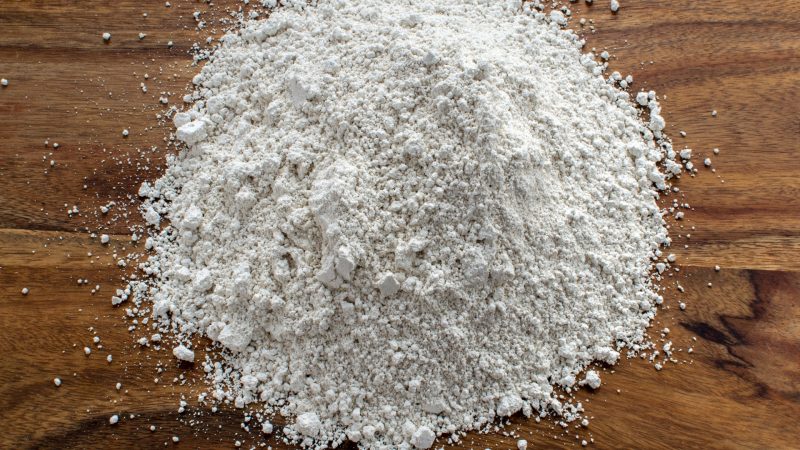Flea bites and infestations can cause itching, irritation, and even infections of the skin. Several natural flea control options are available, and diatomaceous earth is one of the natural solutions that may help you get rid of fleas on your property.
Can diatomaceous earth kill fleas? Diatomaceous earth can kill fleas. For fleas, it’s like crawling over shattered glass. When they encounter diatomaceous earth, it can break their exoskeletons, and microscopic abrasive particles stick to their bodies, absorbing moisture and eventually killing them.
Diatomaceous earth is excellent for flea treatment because it is pesticide-free and simple to apply. Fleas will not build immunity to it since it is a mechanical killer. Here is everything you need to know about flea treatment with diatomaceous earth so that you may make an educated decision for your house and pets.
What Is Diatomaceous Earth?

Diatomaceous earth is a powdery material produced from a soft sedimentary rock found in nature. The fossilized residues of one-celled creatures called diatoms, which naturally contain silica, create this rock over time.
Silica and traces of other natural minerals make up diatomaceous earth. The tiny sharp edges of each particle could irritate insects. It has a natural drying effect, and its particles resemble shards of glass.
Related: Diatomaceous Earth Uses as a Natural Pesticide | Tips and Guide
Types of Diatomaceous Earth
1. Food-Grade
This version includes 0.5 to 2 percent crystalline silica and is safe for human and animal consumption. It is used as a pesticide in the agricultural and food industry.
2. Filter-Grade
Non-food-grade is another term for it. It’s made up of 60% crystalline silica. Although it is toxic to animals, it has a wide range of uses, including dynamite production and water filtering.
Does Diatomaceous Earth Really Work on Fleas?
Diatomaceous earth is a great insect killer that is non-toxic and lasts for a long time. It has long been used to control fleas, bed bugs, ants, and other home pests. This powder has razor-sharp tiny edges that kill insects like fleas. The flea is dried out by diatomaceous earth, which causes it to die.
However, although using diatomaceous earth for fleas is a safe, effective, and environmentally beneficial treatment for humans and pets, it only works on adult fleas and does not kill eggs.
How does Diatomaceous Earth work on Fleas?
Exoskeletons, or hard exterior bodies or shells, are seen on fleas and other insects. When these insects come into contact with diatomaceous earth, the small abrasive particles break their exoskeletons and adhere to their bodies, causing the fleas to dry out and die.
Is Diatomaceous Earth Safe for Pets?

Only food-grade diatomaceous earth should be utilized for pets, humans, and gardens. When used on dogs, cats, or even humans, diatomaceous earth is completely safe.
A maximum of 0.5-2 percent crystalline silica is allowed. This level is non-toxic, which means it is safe for consumption.
How to Use Diatomaceous Earth for Fleas on Cats?
Diatomaceous earth can be applied to cats by simply rubbing it into their coats or dusting it in their surroundings. This is done to keep fleas, lice, ticks, and other pests away from the cat.
Apply it behind the ears, down to the neck, and under the chin. The powder should be massaged down to their back, tail, legs, and tummy. Bathe your cat after three days to remove the dead fleas and use a flea comb to remove any leftover fleas or eggs.
DE is also an organic dewormer that you can give to your cat by mixing one teaspoon into their food or drinking water. Always double-check that the DE is the food-grade one that is safe for humans and animals.
How to Use Diatomaceous Earth to Kill Fleas on Dogs?
Diatomaceous earth can be used to both prevent and cure fleas and ticks. Sprinkle a liberal amount on your dog’s body and massage it through its coat and skin to absorb the product. You may wash the powder from your dog with your choice of dog shampoo after around 8 hours of application.
Diatomaceous earth may be fed to your dog to help them get rid of any internal parasites, such as roundworms. To give it to your dog, sprinkle it over their meal. One tablespoon is advised, and make sure you use food-grade diatomaceous earth.
If you’re going to feed diatomaceous earth to your pet, make sure you give it to them for at least 30 days. This will assure that not only adult worms will be killed, but also hatching eggs and smaller worms in the lungs and stomach.
How Often Should You Put Diatomaceous Earth on Your Dog for Fleas?

- For flea infestations: Use it every 3 to 4 days and wash with your dog’s shampoo. The flea shampoo kills fleas on touch, and the diatomaceous earth kills any fleas that hatch from their eggs.
- For flea prevention: It can be used every 7 to 10 days to eliminate fleas as they develop and avoid infestations.
How Long Does It Take Diatomaceous Earth to Kill Fleas?
Fleas may die in four hours after coming into contact with diatomaceous earth. However, it is advised to wait for up to 36-48 hours to assure its efficiency.
When you leave DE on the carpet it will continue to work as long as you keep it dry. However, it is recommended that you leave it for at least three days before vacuuming it. It takes three days to destroy the larvae and adult fleas and rid your carpet of fleas.
Can You Use Diatomaceous Earth Outside for Fleas?
Diatomaceous earth may be used to eliminate fleas outside of your home. Just make sure that the area is totally dry before applying it since moisture will significantly decrease its efficiency.
Fleas prefer damp, shady environments. They also thrive on lawns that have fungal issues. From these places, spread it out over the surface. You can also concentrate on the places where your pets usually hang out. When applying the product, wear a dust mask.
Does Diatomaceous Earth Kill Fleas in the Yard?
Diatomaceous earth can kill fleas in the yard. Just keep in mind that the food-graded version is recommended. Sprinkle it in locations where your pet spends time, as well as any other areas where you suspect flea infestation.
When diatomaceous earth is combined with water, it loses its effectiveness. As a result, be sure it won’t rain in the following several days. Reapply the solution if it rains.
What to Consider Before Using Diatomaceous Earth?

Health Hazards
Inhaling diatomaceous earth may cause nasal irritation. If a large amount is consumed, coughing or shortness of breath may happen. It can also irritate the skin, cause dryness, and cause eye irritation.
Use Properly
Keep in mind that while using diatomaceous earth to eliminate fleas in your house, you should apply it correctly. Your flea infestation will most likely worsen rather than improve if you don’t use it properly.
Downsides of Using Diatomaceous Earth
Before using diatomaceous earth to get rid of fleas, be sure you’re aware of the risks.
- Its efficiency varies depending on the situation in which it is utilized. In places with more humidity, for example, it may not be as effective.
- Although food-grade diatomaceous earth is safer to use at home, it still poses a risk to pets and people, particularly if breathed. It may cause skin irritation, dryness, and eye irritation when it comes into contact with a person or your pets.
- Diatomaceous earth is also a messy substance. The powder can get all over the place.
Do Vets Recommend Diatomaceous Earth?
According to veterinarians, diatomaceous earth is typically not recommended for use on pets. On the other hand, food-grade diatomaceous earth is perfectly safe for them. Because diatomaceous earth is abrasive, it’s essential to keep it out of the eyes and lungs of your pet because our pets ingest whatever is on their coat when grooming.
Before using diatomaceous earth, we recommend speaking with your veterinarian and getting advice from them on how to use it properly. Take care not to apply it on any open wounds or sores on your pet.
Where to Buy Diatomaceous Earth?
Diatomaceous earth is available for fleas and other pests in hardware stores, pet supply stores, and online websites like Amazon. The most common form is diatomaceous earth powder , which comes in bags but may also be found in jars and bottles.
- Natural Product - Composed of 2lbs of 100% ground freshwater...
- OMRI Listed - Listed with the Organic Minerals Research...
- Powder Duster Included - Powder duster in the bag for easy and...
- Supports a Great Cause - Harris donates 10% of profits to support...
- Made in the USA – Mined in Nevada and packaged in Georgia
If you’re going to use diatomaceous earth at home, make sure you get the food-grade type. Pet parents should make sure they’re buying a product that’s been approved by the EPA.
How to Use Diatomaceous Earth for Fleas?
Diatomaceous earth can be used indoors and outdoors, and it will work as long as it is kept dry. Here’s how to get rid of fleas with diatomaceous earth.
Step 1: Begin by identifying the areas in your home or yard where fleas have been seen. Furniture, pet beds, floors, cracks, and crevices, behind sinks, and even in gardens are all places to look. If the contaminated areas include carpets, beds, or other fabrics, you should vacuum them first to get the fleas moving.
Step 2: Sprinkle the diatomaceous earth powder over the areas to be treated.
Step 3: Allow the powder to settle for a day or two, then vacuum up the powder and dead fleas.
List of Sources
Bunch, T. R., Bond, C., Buhl, K., Stone, D. (2013). Diatomaceous Earth General Fact Sheet. National Pesticide Information Center, Oregon State University Extension Services.
Millier, E. (2011). Diatomaceous Earth for Pest Control. University of California.
Is ‘food grade’ diatomaceous earth okay for pest control? National Pesticide Information Center, Oregon State University Extension Services.
- How to Get Rid of Copperheads | Practical Guide - August 27, 2023
- How to Get Rid of Corn Snakes | What Makes Them Aggressive? - August 27, 2023
- How to Get Rid of Alligators | Safety Measures and Removal Methods - July 16, 2023

